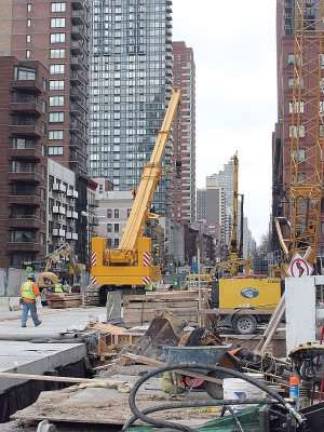Clean Tests, Dirty Looks

Residents question MTA's air quality tests on 2nd Avenue
Those who live in the vicinity of the Second Avenue Subway construction have been concerned for several years about the potential effects that the constant blasting and construction may have on residents' health.
A few weeks ago, MTA Capital Construction released the results of an air quality study that monitored construction activity between East 69th and East 87th streets along Second Avenue. While the report essentially concludes that there is not much to be worried about, local residents aren't necessarily convinced, and many expressed their skepticism at Community Board 8's Second Avenue Subway task force meeting last Wednesday night.
MTA Capital Construction president Michael Horodniceanu told residents at the meeting that they have been working to improve conditions since before the study came out.
"We listened to your concerns about smoke and fumes," Horodniceanu said, noting that they have initiated dust control measures and better smoke ventilation and worked to seal off as much of the dust as possible. "I think we've improved the dust and fume situation considerably."
Over 100 people attended the meeting to listen to the report's findings laid out in detail and voice their concerns over its conclusions. The study was conducted by consulting firm Parsons Brinckerhoff, and it tracked pollutants from 10 monitoring sites over a 28-day period, collecting 3.3 million points of data. Guido Schattanek, the senior environmental engineer who wrote the study, was on hand to go point by point through the data.
The study focused on particulate matter of two sizes; PM10, which means equal to or smaller than 10 microns, and PM2.5, equal to or smaller than 2.5 microns. It also tracked a number of pollutants, including carbon monoxide, sulfur dioxide, ammonia and hydrogen sulfide.
The results of the study surprised some residents. According to the findings, which were verified by the Environmental Protection Agency, none of the pollutants registered at levels that would be harmful to residents' health.
Assembly Member Dan Quart, whose district encompasses the construction, let the community know on Wednesday night that he would be introducing a bill that would require more frequent and regulated testing of the air around the blasting sites.
"My concern is that you're looking at a 28-day period of a construction project that's been going on for three years," Quart said.
"There is no semi-annual or annual means to check the air quality. You wouldn't accept saying that you only come in and inspect an air shaft every three or four years," he said.
The bill would require the state Department of Environmental Conservation to conduct regular studies of the air around the project and respond accordingly to the findings.
"Right now, the community's only avenue is essentially only the MTA hiring a third party," Quart said. "That's not good public policy."
Quart said he worked with Manhattan Borough President Scott Stringer to craft the legislation. Stringer also attended the meeting to encourage residents and city agencies to work to get real solutions, noting that residents have been complaining about dust, debris and unpleasant odors related to the construction for years now.
"We have to work together to keep small businesses and improve the air quality," Stringer said, asking for support of Quart's bill.
The good news for residents is that there is an end date for the blasting, which Horodniceanu said was already 60 percent complete. "Blasting in the main cavern will be done this summer," he said. In April, they will begin blasting at East 86th Street, which is expected to last 15 to 19 months, putting the end at November 2013.